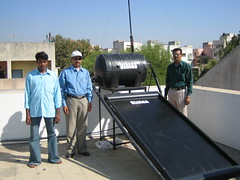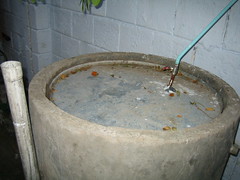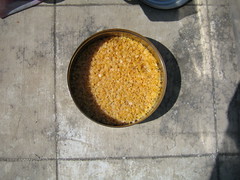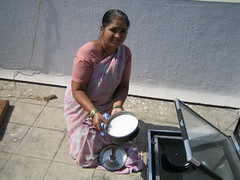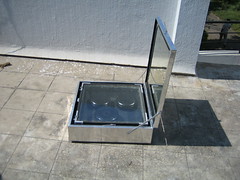Thursday, August 27, 2009
PHOENIX PRODUCTS
PHOENIX PRODUCTS: "D-87, Industrial Estate, Near, KPTCL Sub - Station, Udyambag, BELGAUM - 590 008. KARNATAKA ( India ) Phone : 091-0831-2440700, Fax : 091-0831-2442832 Cell : 9448480725/9242874544/9448863775"
Om Sai Industries
Om Sai Industries: "Address :
Plot No. 21-A, KLE Engg. Collage Road, Udyambag, Belagaum,
Telephone No. :
91-831-2443381"
Plot No. 21-A, KLE Engg. Collage Road, Udyambag, Belagaum,
Telephone No. :
91-831-2443381"
Monday, October 08, 2007
Sarai cooker
This week end I got a chance to try out the Sarai cooker(http://arti-india.org/).
It took 45 minutes of smoke-free cooking to get the rice cooked.The taste of the rice was different than the one cooked in a Pressure cooker over a LPG stove.
Here are some pics
It took 45 minutes of smoke-free cooking to get the rice cooked.The taste of the rice was different than the one cooked in a Pressure cooker over a LPG stove.
Here are some pics
Tuesday, November 29, 2005
The Solar geyser
We installed a Sintex Solar geyser of 125 litre capacity at our home in Nasik.It cost us Rs.14386/- including plumbing.
The installation took a day and this pic was clicked on the 2nd day when Mr.gotiwale,Mr.Jadhav and the plumber had come down for testing the unit.
Henceforth,we would depend much less on gas and other conventional sources for water heating.
Thanks once again to "Surya" Dewata..or Lord Sun.
The installation took a day and this pic was clicked on the 2nd day when Mr.gotiwale,Mr.Jadhav and the plumber had come down for testing the unit.
Henceforth,we would depend much less on gas and other conventional sources for water heating.
Thanks once again to "Surya" Dewata..or Lord Sun.
Tuesday, November 08, 2005
Bio-Gas Plant at Susanji,Cherlapally Ind estate
We started our efforts on generating bio-gas from wheat flour some 6 months back and were fortunate enough to have succeeded within 6 months of starting off.
In the adjoining picture,you can see the bio-gas unit setup.It does not use cow-dung.So can be used and maintained in urban environments.
Now we are experimenting on generating gas from kitchen waste.
We need help on understanding the details of the anaerobic fermentation process.
We used potato peels instead of what flour-paste.But that did not generate gas.maybe the bacteria did not act on that.we need to understand why.also,we want to know what could be added so that the bacteria wud act on the kitchen waste and facilitate anaerobic fermentation.
The search is on.......
In the adjoining picture,you can see the bio-gas unit setup.It does not use cow-dung.So can be used and maintained in urban environments.
Now we are experimenting on generating gas from kitchen waste.
We need help on understanding the details of the anaerobic fermentation process.
We used potato peels instead of what flour-paste.But that did not generate gas.maybe the bacteria did not act on that.we need to understand why.also,we want to know what could be added so that the bacteria wud act on the kitchen waste and facilitate anaerobic fermentation.
The search is on.......
The Daal
The solar rice
My mother with the rice cooked in the solar cooker.
We prefer to call it the "Solar Rice" :)
We prefer to call it the "Solar Rice" :)
The Solar cooker
We had been planning to get the Solar cooker from a long time.
Finally when we had an independent bungalow built,we decided to buy one and this Diwali,we got a 4 pot solar cooker for ourselves.The price was Rs.1800/-
Its proving to be very useful gadget and my mother has already started using it daily to cook rice and daal.We also fried some groundnuts.
Some ghee was also made using the cooker.
We are really enjoying the independence..Only if we could cook Chapatis in this cooker,we would have completely eliminated the gas stove from our kitchen.
A billion thanks to Aditya-Lord Sun !!!!!
Finally when we had an independent bungalow built,we decided to buy one and this Diwali,we got a 4 pot solar cooker for ourselves.The price was Rs.1800/-
Its proving to be very useful gadget and my mother has already started using it daily to cook rice and daal.We also fried some groundnuts.
Some ghee was also made using the cooker.
We are really enjoying the independence..Only if we could cook Chapatis in this cooker,we would have completely eliminated the gas stove from our kitchen.
A billion thanks to Aditya-Lord Sun !!!!!
Friday, December 17, 2004
Utilization of Jatropha
The jatropha plantation creates a positive correlation between energy production and food production. It promotes following main aspects of development whick combine to help assure a sustainable way of life for rural kishan and the soil that supports them. *EXTRACTION OF BIOFUELS-the renewable energy:- It was successfully introduced as fuel for simple engine-driven oil presses,grain mills and water pumps. *EROSION PROTECTION AND INCREASE OF SOIL QUALITY:- Jatropha hedges reduce wind erosion of the soil and keep off animals.The press cake,by-product of the oil production can be used as bio fertilizer. *PROMOTION OF WOMEN *POVERTY REDUCTION IN RURAL AREAS:- Jtropha oil has been used by women for medicines and for soaps. Intergrating the machines into the process without having to pay for cash for the fuel increases productivity and income
A WALK TOWARDS GREEN WEALTH
IF-10 MILLION HECTATRES OF LAND IS BROUGHT UNDER JATROPHA PLANTATION-CAN YIELD 15 MILLION TONS OF SEED @1.5 TON/ HECTARE-4 MILLION TONS OF OIL-AN EQUIVALENT AMOUNT OF BIODIESEL, I. E. ONE TENTH OF COUNTRY'S REQUIREMENT-HUGE GENERATION OF EMPLOYMENT POTENTIAL IN RURAL AREAS*IF ONLY ONE MAN/WOMAN IS EMPLOYED/HECTR FOR JATROPHA CULTIVATION ADDITIONAL 2 MILLIOM NEW JOBS*200 NEW EXTRACTION UNITES OF 250TPD CAPACITY TO CRUSH THE SEEDS-11 MILLIONS OF GOOD ORGANIC MANURE-0.4 MILLION OF TECHNICAL GRADR GLYCEROL
BIODIESEL FROM JATROPHA
Why Bio Diesel ?
Many alternative Bio Diesel fuels have been shown to have better exhaust emissions than traditional Diesel fuel. Jatropha Bio diesel holds promise as fuel alternatives for diesel engine because :-
Bio Diesel are renewable fuelDepletion of the Primary FuelsBio Diesel are agriculture orientedA number of researches have shown that jatropha bio diesel has fuel properties and provides engine performance that is very similar to diesel fuel
The severe emission regulations in the world have placed design limitations on heavy duty diesel engines. The trend towards cleaner burning fuel is growing worldwide and it is possible through Jatropha bio diesel.
Bio diesel includes a high cetane number, low sulfur , low volatility and the presence of Oxygen atoms in the fuel molecule
Expected efficiency is achieved through Bio diesel.Bio diesel performs better than the Petroleum dieselJatropha bio diesel readily mixes with diesel fuel and it runs in any diesel engine without modificationReduces serious air pollutants such as particulates, carbon monoxides, hydrocarbons and air toxic
Jatropha curcas - Bio Diesel & Other usesPotential Varieties of Bio Diesel oil seeds1. Jatropha Curcas2. Karanja (Pungam)3. Jojoba4. Kusum5. Mahua6. Neem
Nearly 80 species are known to produce oil from seeds
Even though there are plenty of varieties of tree borne oil seeds, Jatropha Curcas shrubs 31 to 37 % of oil is extracted from a Jatropha seed. Jatropha Curcas seed can be used as Bio diesel for any diesel engine without modification
Selling treated Jatropha seeds, and quality sapling
Dark blue dye and wax can be produced from the bark of the Jatropha curcas plants
Jatropha plant Stem is used as a poor quality wood : Bio fuel
Jatropha curcas leaves helps in dressing the wound.
Jatropha roots help in making yellow dye
Juice of the flowers of Jatropha curcas and the Jatropha stem has very good medicinal properties
Pounded seeds are used in tanning
Press Cake : Jatropha becomes Organic fertilizer and soil improver
Jatropha curcas extracted oil are used as :Bio Diesel, Varnishes, Illuminants, Soap, Pest control and Medicinal for skin diseases, and others
A WALK TOWARDS GREEN WEALTH
IF-10 MILLION HECTATRES OF LAND IS BROUGHT UNDER JATROPHA PLANTATION-CAN YIELD 15 MILLION TONS OF SEED @1.5 TON/ HECTARE-4 MILLION TONS OF OIL-AN EQUIVALENT AMOUNT OF BIODIESEL, I. E. ONE TENTH OF COUNTRY'S REQUIREMENT-HUGE GENERATION OF EMPLOYMENT POTENTIAL IN RURAL AREAS*IF ONLY ONE MAN/WOMAN IS EMPLOYED/HECTR FOR JATROPHA CULTIVATION ADDITIONAL 2 MILLIOM NEW JOBS*200 NEW EXTRACTION UNITES OF 250TPD CAPACITY TO CRUSH THE SEEDS-11 MILLIONS OF GOOD ORGANIC MANURE-0.4 MILLION OF TECHNICAL GRADR GLYCEROL
BIODIESEL FROM JATROPHA
Why Bio Diesel ?
Many alternative Bio Diesel fuels have been shown to have better exhaust emissions than traditional Diesel fuel. Jatropha Bio diesel holds promise as fuel alternatives for diesel engine because :-
Bio Diesel are renewable fuelDepletion of the Primary FuelsBio Diesel are agriculture orientedA number of researches have shown that jatropha bio diesel has fuel properties and provides engine performance that is very similar to diesel fuel
The severe emission regulations in the world have placed design limitations on heavy duty diesel engines. The trend towards cleaner burning fuel is growing worldwide and it is possible through Jatropha bio diesel.
Bio diesel includes a high cetane number, low sulfur , low volatility and the presence of Oxygen atoms in the fuel molecule
Expected efficiency is achieved through Bio diesel.Bio diesel performs better than the Petroleum dieselJatropha bio diesel readily mixes with diesel fuel and it runs in any diesel engine without modificationReduces serious air pollutants such as particulates, carbon monoxides, hydrocarbons and air toxic
Jatropha curcas - Bio Diesel & Other usesPotential Varieties of Bio Diesel oil seeds1. Jatropha Curcas2. Karanja (Pungam)3. Jojoba4. Kusum5. Mahua6. Neem
Nearly 80 species are known to produce oil from seeds
Even though there are plenty of varieties of tree borne oil seeds, Jatropha Curcas shrubs 31 to 37 % of oil is extracted from a Jatropha seed. Jatropha Curcas seed can be used as Bio diesel for any diesel engine without modification
Selling treated Jatropha seeds, and quality sapling
Dark blue dye and wax can be produced from the bark of the Jatropha curcas plants
Jatropha plant Stem is used as a poor quality wood : Bio fuel
Jatropha curcas leaves helps in dressing the wound.
Jatropha roots help in making yellow dye
Juice of the flowers of Jatropha curcas and the Jatropha stem has very good medicinal properties
Pounded seeds are used in tanning
Press Cake : Jatropha becomes Organic fertilizer and soil improver
Jatropha curcas extracted oil are used as :Bio Diesel, Varnishes, Illuminants, Soap, Pest control and Medicinal for skin diseases, and others
Tree Provides Biodiesel For India By Keya Acharya
BANGALORE, India, April 8, 1998 (ENS) - Since February 1998, the oil from the seed of the Pongamia pinnata tree is being used as a substitute for diesel in electricity generation in rural Karnataka state. The tree is native to the Western Ghats of India, and distributed eastwards to Fiji and Australia. This form of fuel is being used in a project called SUTRA (Sustainable Transformation of Rural Areas) run by scientists from Asia's premier scientific research institution, the Indian Institute of Science. Professor Udupi Shrinivasa, Head of the Department of Mechanical Engineering, at the Indian Institute of Science, based at Bangalore, is also head of SUTRA. He is optimistic that pongamia oil will prove to be a practical and inexpensive substitute for diesel to serve power needs in rural areas. Shrinivasa has filed for a patent on the commercial use of pongamia oil as an alternative fuel. SUTRA is currently being funded by India's Ministry of Non-Conventional Energy and the state government of Karnataka. In the year 2000, SUTRA will be granted US$10 million from the Global Environment Facility, a body set up to help conserve the world's biodiversity, and funded by the World Bank, United Nations Environment Programme and United Nations Development Programme. Then plans are to replicate the project in other states of India. Pongamia tree Characteristics of the pongamia tree. The pongamia tree yields anywhere between nine to ninety kilos (20 to 200 pounds) of seeds per year. One kilo (2.2 pounds) of seeds produces one-quarter of a kilo of oil. The residual crushed seed, known as oil cake, is a good source of manure. One kilo of oil generates three units of electricity, and the economics of all this works out to much lower than the current price of diesel. The villages in Karnataka are already familiar with pongamia oil and seed. They use the oil for lighting lamps and the seed for soil fertiliser. Biodiesel or fuel from renewable products is not a new concept - Rudolf Diesel himself experimented with vegetable oils in his engine in 1900. Before World War II, the multi-fuel ability of the diesel engine was recognised, but inexpensive and readily available petroleum fuels overtook vegetable oils. The OPEC embargo and subesequent price increases in the 1970s renewed research in using vegetable oils as fuels. More recently, concern over the environmental impacts of fossil fuels has increased impetus for research in biodiesels. The most common subjects of alternative fuel experiments are sunflower, rapeseed, castor, flax, palm, and coconut oils as well as animal fats. Biodiesel has been extensively tested by government agencies, university researchers and private industry in the United States, Canada and Europe. More than one hundred biodiesel tests, including three one-million-mile tests have been completed. Performance, fuel mileage and driveability were found to be similar to petrodiesel fuel. The most notable difference is that vegetable based fuels emit less exhaust fumes. In Europe, Austria has led the way in standardising biodiesel. Austria has made it mandatory to use biodiesel in areas of high risk to the environment, which immediately created a domestic market for production of vegetable oil fuel. A recent proposal to the European Council to allow use of biodiesel in diesel engines borrows heavily from Austrian standards. The most significant deterrent to biodiesel use in Europe and America is its high price in these areas. Even with improved technologies, it still costs more to produce a litre of biodiesel than a litre of petrodiesel. Special tax treatments would be needed to promote commercial use of this fuel. Another drawback to biodiesel is the high viscosity or thickness of vegetable oils which results in early engine damage. More research is currently being conducted for improvement in this area. The situation in developing countries, on the other hand, is the opposite. Most developing countries cannot afford to import petroleum based fuels to generate industry. But most also have access to sources of vegetable fuels like the pongamia which is distributed in tropical regions. So in developing countries, vegetable oils could become cheaper than petrodiesel, even if the diesel is heavily subsidised, as in India. In developing countries, there is no shortage of manpower for technical maintenance of the engines. Frequent cleaning of fuel injectors and filters are less of a problem. In the case of pongamia oil, Shrinivasa says a simple filtering in rural areas is sufficient. In colder parts of India and other developing countries, the problem of freezing of waxes and gums in the oil could be solved by simple heating. It may be possible to encourage the sustainable growth of the pongamia tree on India's over 90 million hectares (roughly 2 billion acres) of degraded lands. Since the tree is not grazed upon by cattle, rural areas could well be serviced in energy, economic and environmental benefits by the pongamia pinnata.
Isolated hamlet in Indian forest gets electricity from seed-powered generator
KAMMEGUDA, India (AP) _ Deep in the tropical forests of southern India, the Kolam people were untouched by telephones, cars or television, and they went to bed at dusk because there was no electricity. Their village is still far from a road or a power line. Yet, for the past year, dozens of 40-watt light bulbs have begun to glow in the mud and bamboo huts just minutes after the sun sets. The villagers have found that electricity grows on trees _ specifically the seeds of the Karanji trees in the nearby forest, which they're turning into biodiesel fuel to power a generator. Instead of going to sleep at sunset, children are now busy practicing their alphabet in the community center each evening, writing their names on black slates and showing them to proud village elders, who never went to school. ``Our place has changed a lot,'' said Kammeguda's oldest man, Aathram Maru Patel, who does not recall his age and has never been away from the village. The Kolams gather the seeds from the surrounding forest and take a few hours to extract the oil, using a mill powered by the generator that provides the electricity. There is substantially less pollution than from petroleum-based diesel, and no power bill. ``With lights, we can chase away snakes and animals that stray into our village in the night. We can catch the occasional thief also,'' said Lakshmi Bai, chosen by her community to manage the tiny power station. ``Earlier, we used to put our children to sleep early, but now we make them study under the lights,'' she said. Udupi Shrinivasa, a gray-haired, bespectacled mechanical engineering professor at the Indian Institute of Science, walked into the village just over a year ago and lit up the Kolams' lives. For years, he had been teaching the institute's students about the mechanics of the diesel engine and the plan of its German inventor, Rudolph Diesel, for it to run on vegetable oils as a source of cheap energy. Researchers around the world are working on replacing oil-based diesel with biodiesel fuels, which can be made from a variety of agricultural products from animal fat to soybeans, and Shrinivasa decided to apply that idea for the benefit of power-starved Indians. ``All we did was to take this rudimentary technology to people who had no means of getting all the energy they needed,'' he said at his office in Bangalore, 900 kilometers (560 miles) south of this village in Andhra Pradesh state. Until about 10 years ago the Kolams hunted animals for food and lived in isolation. The state government then weaned the tribe away from hunting and they now keep poultry and cattle. The electrical system has brought further change, and people from other villages in the forest are coming to see the lights of Kammeguda. At sunset, the generator starts up and lights about 60 bulbs in 35 households, the 100-square-foot (nine-square-meter) community center with bamboo walls and the village's single lane. As children study in the center, people sing community prayers and women paint their palms with decorative patterns of henna, a bright red herbal paste. Women no longer have to walk a few kilometers (several miles) to fetch water. The generator runs a pump that draws underground water for storage in an overhead tank. Next on the village's wish list is a television set and a video cassette player. Shrinivasa says the experiment in Kammeguda points to a possible solution of the power shortages that hinder economic expansion in India, home to a billion people. And biodiesel generators also could help cut India's annual US$18 billion bill for oil imports, he said. Fifty-five percent of all rural households _ 77 million village homes _ do not have electricity. Even in the cities, only 87 percent of people have connections, and there are frequent power outages. For cooking, lighting and heat, most villagers have to use firewood or kerosene, a dirty-burning fossil fuel whose sulfur and carbon monoxide can cause skin irritation and respiratory problems. Kammeguda's 120 inhabitants have put that behind them. ``Years ago, they lived primitive lives. We worked with them patiently to change many of their practices,'' said Raj Prakash, an officer with the government's tribal development agency, which began working with the Kolams a decade ago. ``They started wearing full clothes, putting their children in school, vaccinating them against diseases and cultivating crops. Now, electricity has made them ask for more.'' Working with Shrinivasa, the agency has helped the villagers grow Karanji trees and manage the project. Ten thousand trees planted by the Kolams last year will start yielding seeds soon. The generator also is proving a boon for neighboring tribes, who also are making seed oil and selling it to the Kolams. Suryakala, a 7-year-old in Kammeguda, is happy she can devote more time to studying. She says her father has always told her that God provided in the jungle everything the villagers needed _ and now she has proof. ``God has given us light so that we can study,'' she said.
